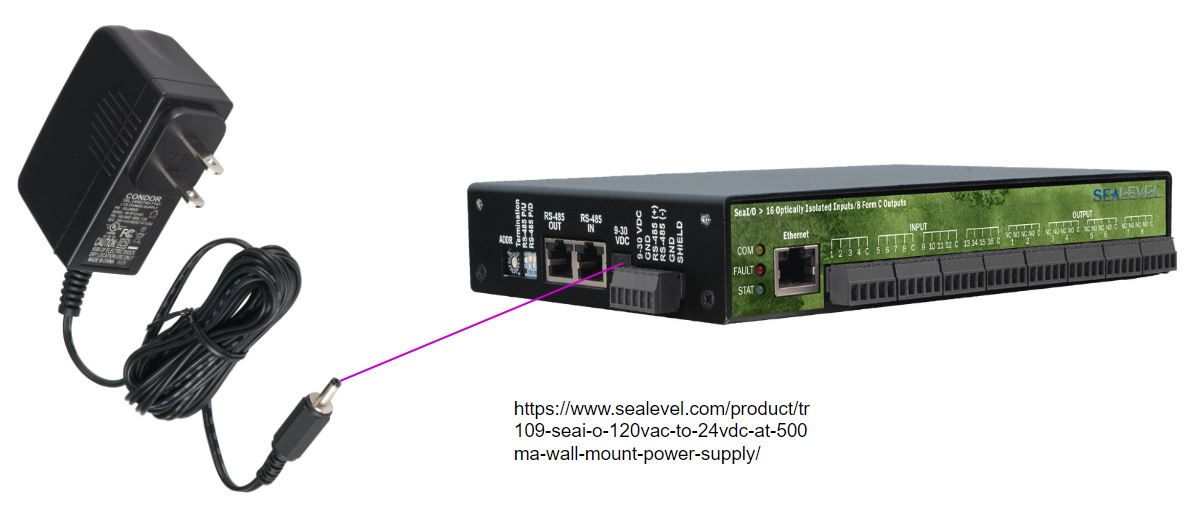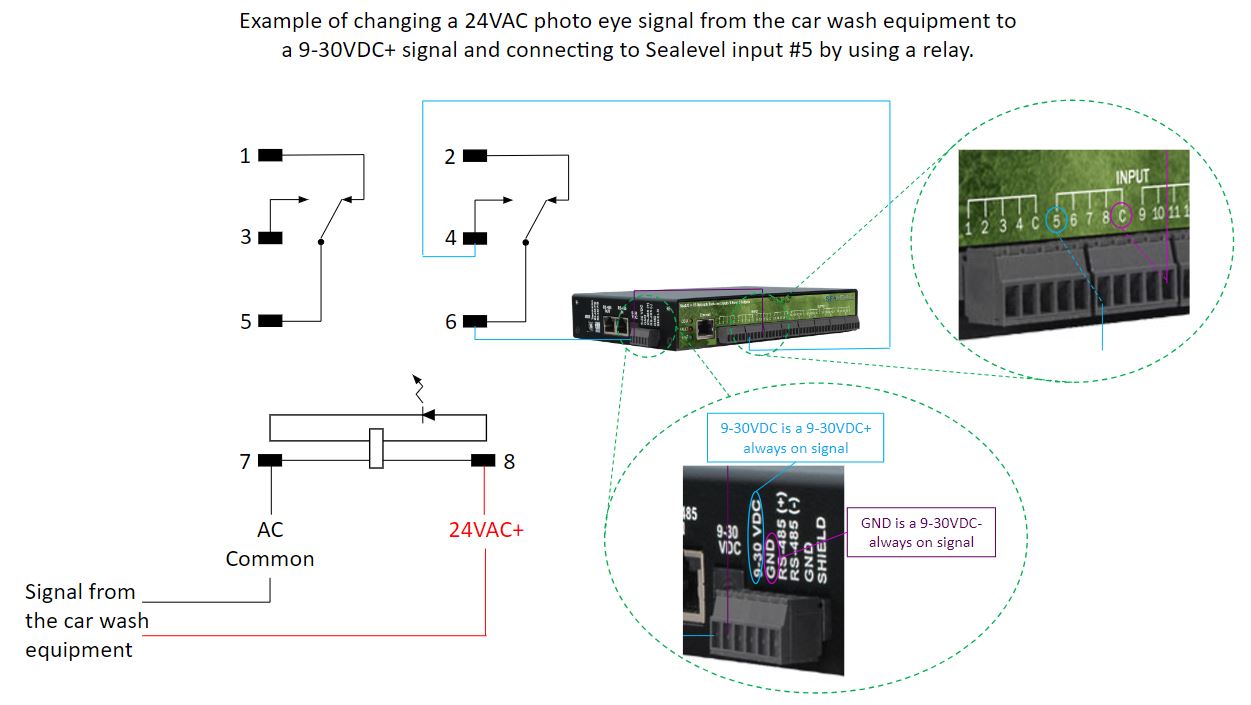Sealevel I/O Wiring Interface
(In Bay Automatics)

Sealevel I/O Interface
The following pages show the wiring setup for the Sealevel I/O interface including power and signaling. Use this as a guide when a Quick Reference Guide is not available for your particular car wash equipment. If a quick reference guide is not available for your equipment, please send us detailed pictures of your final setup and we will make a quick reference guide and give you credit for it. Your peers will thank you!
The Sealevel is a DC powered and signaled device. Do not connect an AC power supply or AC signals directly to the Sealevel inputs. This will cause device failure.
However, AC signals can be passed through the relay outputs. These are single pole/double throw (SPDT) dry contact relays that can pass through what is connected to the output common terminal.
The following pages are broken down into these sections:
1) Powering the Sealevel device
2) Input signaling
3) Output signaling
4) Trouble shooting tips
Powering the Sealevel device
The Sealevel can be powered by:
1) Your DC power source, or
2) Your 24VAC power source using the supplied 24VAC to 12VDC converter, or
3) A traditional AC to DC power supply.
Option 1 - Your DC power source
Option 2 - Your 24VAC power source
Option 3 - A traditional AC to DC power supply.
Input Signaling
Do not connect AC signals directly to the Sealevel inputs. This will cause device failure. Input signals must be DC. If your car wash equipment runs off AC signals, please follow the AC to DC signal conversion diagram below.
There are only 2 functions the car wash equipment needs to signal to the Sealevel. They are 1) wash equipment status, and 2) vehicle location. This is accomplished by using up to 4 inputs on the Sealevel.
GOTCHA: The Sealevel reads the signal side of car wash equipment relays, not the output side. Look at some of the Quick Reference Guides pictures to see how the wiring to the Sealevel is double-tapped on the signal side of the car wash equipment relays.
Wash Equipment Status
Wash equipment status is signaled to the Sealevel via either a single wire or two discreet wires. In a single wire setup, the [Wash in Use, Wash Ready, Next Wash, Out of Service] signal is signaled to the Sealevel over a single wire and this wire is connected to Input 1 on the Sealevel. In a two-wire setup, the Out of Service signal is a discreet signal from the car wash equipment and should be connected to Input 3. In order for the Sealevel to read the signal, the common (C) on input block 1 (Inputs 1-4) must be opposite the signal voltage. For example, if the signal voltage is +24VDC, the common must be -24VDC.
Vehicle Location
Vehicle location is signaled to the Sealevel by tapping physical sensors at the car wash. Common location indicators are photo eyes, gate inductive coils, treadles or sign outputs. Vehicle location is used to perform two functions: 1) pay station reset, and 2) license plate capture. These functions can be signaled via separate signals or the same signal.
Answer these two questions:
1) What physical sensor will be utilized to tell the pay station to reset and accept payment from the next customer?
2) What physical sensor will be utilized to tell the pay station to take a picture of the license plate on the vehicle (LPR capture)?
In a short entrance setup, (no vehicle stacking between the pay station and the car wash entrance), the entrance photo eyes are typically used to signal the pay station to reset and to take a picture of the license plate (LPR capture).
In a long entrance setup, (vehicles are stacked after the pay station before entering the car wash), the gate inductive coil signal is typically used to signal the pay station to reset, and entrance or exit photo eyes are typically used to signal the pay station to take a picture of the license plate (LPR capture).
Photo eyes and gate inductive coils are frequently signaled using opposite voltages. Since the Sealevel needs a common signal voltage that is opposite the signal voltage of the sensor to be able to read the signal, the inputs utilized for vehicle location capture are split across two input blocks.
Vehicle location can be captured using Input 2 and/or Input 5 on the Sealevel. By convention, we have typically used Input 2 for gate signaling and Input 5 for photo eye signaling, but this is not a requirement. The Dencar system can be configured to utilize Input 2 and/or 5 to perform the pay station reset function and the license plate capture function. The determining factor for which input to use is based on the voltage of the signal.
If we continue with the same example as used above for the [Wash in Use, Wash Ready, Next Wash, Out of Service] being a +24VDC signal and we applied a -24VDC common (C) to Input block 1 (Inputs 1-4), we need to know what the vehicle location sensor signal voltage is. Let's assume we want to use the entrance photo eyes as both the pay station reset and the LPR capture and that the entrance photo eyes use a -24VDC signal voltage. This means we need a +24VDC common to read the photo eyes. Since the common on Input block 1 has already been set to -24VDC, we can't use Input 2 to read this signal. In this case, we would apply a +24VDC common (C) to Input block 2 (Inputs 5-8) and connect the -24VDC photo eye signal to input 5. We would then configure the Dencar pay station to reset the pay station and signal the LPR off Input 5.
Keep in mind, if you run into issues double-tapping into a location signal, you can always just install a separate set of photo eyes.
What do I do if my car wash equipment uses 24VAC signals?
If your car wash equipment uses 24VAC signaling, you can interface to the Sealevel I/O Interface unit with a relay.
The following information shows an example of changing a 24VAC photo eye signal from the car wash equipment to a 24VDC signal and connecting to Sealevel input #5 by using a relay.
Sample Relay
This sample relay can be purchased on Amazon.
mxuteuk 2pcs JQX-13FL AC 24V Coil 8 Pin 10A DPDT LED Indicator Electromagnetic Power Relay, with Base, with DIN Rail Slotted Aluminum
- Product Name: Electromagnetic Power Relay; Relay Model : JQX-13FL; Type : DPDT(2NO 2NC); Number of Terminals : 8 ; Socket Model : PTF08A-E
- Coil Voltage: AC 24V; Contact Capacity: 10A 250VAC/10A 28VDC;
https://www.amazon.com/dp/B07R4RQNGX/ref=cm_sw_r_apa_i_TVVVS246Y7CWBS1MJ856_0?_encoding=UTF8&psc=1
Relay coil control:
Connect your 24VAC+ signal to screw terminal #8
Connect your AC common wire to screw terminal #7
Relay Contacts for Sealevel signal:
Connect screw terminal #6 to a 24VDC+ source that is always on. If you use the 9-30VDC source on the Sealevel, the signal will be 9-30VDC as shown in the following diagram. Hence, if you used a 12VDC power source to supply the Sealevel, the 9-30VDC signal would be 12VDC.
Connect screw terminal #4 to Sealevel input #5. This is the first terminal that is on the second block from the front left on the Sealevel. The common terminal for that block (last terminal on the right on that block labeled “C”) should already be connected to a DC negative source.
Output Signaling
While it is a requirement that Input signals to the Sealevel device be DC, the Sealevel will output whatever is connected to the output common. AC signals can be passed through the relay outputs. These are single pole/double throw (SPDT) dry contact relays that can pass through what is connected to the output common terminal with a 60VDC max. / 50VAC max.
There are 8 outputs on the Sealevel device. Output 1 is the Bronze wash tier. Output 2 is the Silver wash tier. Output 3 is the Gold output tier. Output 4 is the Platinum wash tier. Outputs 5-8 are buyup tiers. Buyups can be signaled as simple buyups or as signaled buyups. Wire the Sealevel outputs to the car wash equipment inputs using the voltage required by the car wash equipment.
A simple buyup is a completely configured wash package typically used on older style car wash equipment. For example, if you use a Bronze wash tier with no undercarriage, and you want to offer a buyup for undercarriage, wash tier 1 in the car wash equipment would be configured for the Bronze wash and wash tier 5 would be configured for the same Bronze wash configuration with the addition of the undercarriage pass. In this way, a Bronze wash is signaled via output 1 and a Bronze buyup is signaled via output 5. In a simple buyup configuration, only 1 output is signaled. The buy up pairing is Bronze 1-5, Silver 2-6, Gold 3-7, Platinum 4-8.
A signaled buyup signals the wash tier followed by the buyup(s). This is commonly referred to as Sequential Signaling. In this case, the buyup is configured to the output and can be signaled across wash tiers. This allows individual or multiple buyups to be signaled per wash tier. Watch the below video for a visualization of Sequential Signaling.
Trouble Shooting Tips
If you run into a situation where the Sealevel service regularly drops offline, this is most likely caused by a power or network wiring problem. Take these steps to resolve the issue:
1) Switch to a traditional AC to DC power supply. Order directly from Sealevel with this link: https://www.sealevel.com/product/tr109-seai-o-120vac-to-24vdc-at-500ma-wall-mount-power-supply/
2) Switch your network wiring to machine-made cables. Order from Amazon with this link: https://www.amazon.com/AvesView-Ethernet-High-Speed-Snagless-PlayStation/dp/B0CXBSFZ82/ref=sr_1_1_sspa?crid=H4HP3SFVC3RH&dib=eyJ2IjoiMSJ9.IQ2K24qDQlAuCtg1JZ25RMVK0PZF2Mt7oG6Pr7lwdk3-KcI5E9Jppy9mNmp-Gdp7y3HoKWaJA_wWkXDw-RsjcUoM5mszhv_Nf-tRu6OrNeDuUUP9BtJrGFSKFhILabtpc-xD0iqCfI2eKVPqhvSq65Jdk_CWkiygzV1UTV7uT4mBRQ1Tr2lyviPKs_HavTuGpAvgK8k8wYpqbAuGdFSprwnkk98ZzPjKytzpQd07SFc.fBzK8hi47fxthqn-HQVMOkzePRRU74jRMLOWFY7zgAg&dib_tag=se&keywords=network%2Bcables%2B25%2Bft&qid=1725867482&sprefix=network%2Bcables%2Caps%2C209&sr=8-1-spons&sp_csd=d2lkZ2V0TmFtZT1zcF9hdGY&th=1
3) Ensure your network wiring does not run past or near any high voltage devices that could interfere with the network signal. We have seen at least one VFD emitting enough electrical interference to impact the network signaling.




